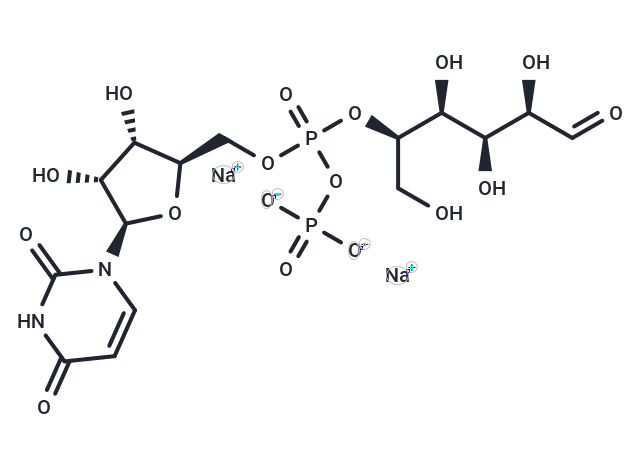Shopping Cart
- Remove All
 Your shopping cart is currently empty
Your shopping cart is currently empty

Uridine 5′-diphosphoglucose disodium salt (UDP-Glucose sodium salt) is an endogenous nucleotide sugar involved in glycosyltransferase reactions in metabolism. It is an agonist of the P2Y14 receptor (EC50 = 0.35 μM) and can also bind to and activate GPR17, inducing oligodendrocyte differentiation at a maximal concentration of 100 μM.

| Pack Size | Price | Availability | Quantity |
|---|---|---|---|
| 100 mg | $42 | In Stock | |
| 500 mg | $95 | In Stock |
| Description | Uridine 5′-diphosphoglucose disodium salt (UDP-Glucose sodium salt) is an endogenous nucleotide sugar involved in glycosyltransferase reactions in metabolism. It is an agonist of the P2Y14 receptor (EC50 = 0.35 μM) and can also bind to and activate GPR17, inducing oligodendrocyte differentiation at a maximal concentration of 100 μM. |
| Targets&IC50 | P2Y14 receptor:0.35 μM (EC50) |
| Alias | Uridine 5'-diphosphoglucose disodium sal, UDP-α-D-Glucose sodium salt, UDP-Glucose sodium salt, UDPG sodium salt |
| Molecular Weight | 610.27 |
| Formula | C15H22N2Na2O17P2 |
| Cas No. | 28053-08-9 |
| Smiles | [Na+].[Na+].OC[C@@H](OP(=O)(OC[C@H]1O[C@H]([C@H](O)[C@@H]1O)n1ccc(=O)[nH]c1=O)OP([O-])([O-])=O)[C@@H](O)[C@H](O)[C@@H](O)C=O |
| Relative Density. | no data available |
| Storage | store under nitrogen,keep away from moisture | Powder: -20°C for 3 years | In solvent: -80°C for 1 year | Shipping with blue ice. | |||||||||||||||||||||||||||||||||||
| Solubility Information | H2O: 125 mg/mL (204.83 mM), Sonication is recommended. | |||||||||||||||||||||||||||||||||||
Solution Preparation Table | ||||||||||||||||||||||||||||||||||||
H2O
| ||||||||||||||||||||||||||||||||||||

Copyright © 2015-2025 TargetMol Chemicals Inc. All Rights Reserved.